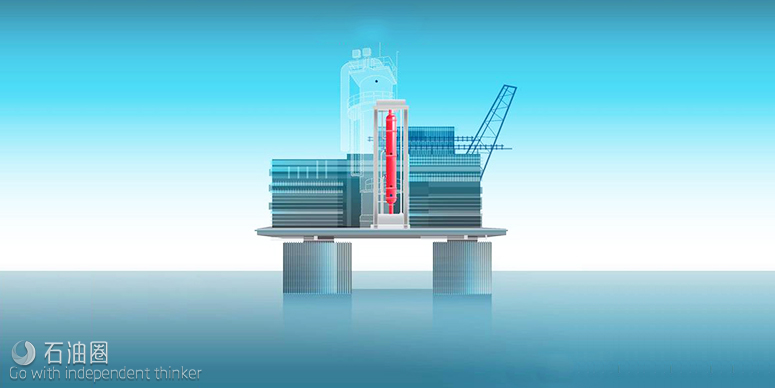A new in-line natural gas dehydration technology removes water from the production stream without a traditional tower.
When it comes to dealing with gas production, one of the chief concerns is how to separate water from the gas, necessary to reduce corrosion and equipment interference and to ensure efficient transport of the production fluids.
“All gas is saturated with water, and somewhere in the process all that water needs to be removed,” says Don Shatto, equipment technologies manager at ExxonMobil Upstream Research Company.
The need to separate gas and water led to conventional dehydration tower technology, which relies on a large pressure vessel, or contactor, that brings natural gas into contact with glycol. The glycol absorbs the water out of the gas and is then regenerated and reused while the dehydrated natural gas is sent on to the sales pipeline.
“cMIST provides a step change in the efficiency of achieving this separation and significantly reduces the operating footprint,” Norman Yeh, engineering specialist with ExxonMobil Upstream Research Company, says. “We focused on replacing the contactor and making use of the rest of the system that is standard.”
The conventional tower is the heaviest piece of equipment in the dehydration system, sometimes weighing 100 tons and taking up to 3000 cubic feet of space or more. Reducing the footprint and weight of the dehydration system would drive down costs for the facility, and could also increase efficiency at the same time.
Yeh estimates the cMIST technology could decrease the footprint and weight of the large pressure vessel alone by as much as 70%. When combined with a cyclonic separator, a conventional glycol regeneration package — reboiler, pump, filters and so on — Yeh says the cMIST still offers as much as 50% savings in weight for the total dehydration system.
“A benefit is the reduced height and what that implies about the construction execution method,” Shatto says.
“The tallest cMIST inline separators would be about 14 feet (4.25 metres) tall. They can be packaged into a skid or module and could be truckable,” he says. “That’s a huge difference in cost, especially for remote or offshore locations.”
“cMIST is a great example of process intensification.” Don Shatto, ExxonMobil Upstream Research Company
Development of the cMIST system began in 2008. In 2015, ExxonMobil started a field test at a compressor station in Ardmore, Oklahoma. The field trial, completed last year, demonstrated that cMIST could efficiently dehydrate raw gas. The company finalised some technology qualifications and in January, 2017, licensed cMIST technology to the Chemtech division of separation technology specialist Sulzer, to facilitate deployment across the oil and gas industry.
“By leveraging our industry-leading experience with upstream applications, our researchers were able to create this advanced natural gas dehydration technology, which represents a step-change in operational efficiency and a significant reduction in footprint,” says Tom Schuessler, president of ExxonMobil Upstream Research Company.
The technology is primarily intended for new fields but could be easily retrofitted into brownfields, says Yeh: “It’s just extra sections of piping.”
Separation
The technology relies on a proprietary droplet generator to break up conventional solvent into tiny droplets that become well dispersed in the gas flow, increasing the surface area for the absorption of water from the gas. Next, an inline separator coalesces the water-rich glycol droplets and moves them to the outside wall of the pipe for effective separation from the dehydrated natural gas. The water-rich glycol is regenerated using a conventional system and is sent back to the droplet generator for re-use.
cMIST relies on the flow of the gas to shear the liquid and spin the flow, so the separation depends on the velocity of the gas, Yeh says.
A system that produces at half of its design flow may “have some separation efficiency losses,” he says. Some of the glycol may not be separated out, requiring further attention downstream.
Running two parallel units can address that, he says, although there is a trade-off from the additional weight and footprint required by the second cMIST unit.
The process can be repeated in multiple stages. The Oklahoma pilot test used two stages to meet sales pipeline specifications, but Yeh estimates the system could work with as many as four stages if required to meet more stringent dehydration specifications. He says the system may not be suitable for more challenging applications such as NGL recovery, which would require too many stages or systems that do not use glycol.
While conventional towers are vertical, the cMIST system can be horizontal or vertical.
“It’s insensitive to orientation or motion,” Yeh says, noting this is particularly helpful for offshore applications where a conventional tower on a floating production unit may rock in the ocean, causing the liquid in the tower to slosh.
A-ha moment
“Our focus has been about making things more compact to help make projects more economic, especially offshore and high-pressure applications,” Yeh says. “We have a high degree of interest in making our equipment more compact while achieving more process functionality.”
Interest in cMIST began around 2008 as the company sought a more efficient method to remove water from natural gas. After screening several options, Yeh says, researchers determined that dehydration would meet the company’s needs and also had wide application. Development from proof of concept testing to the pilot test took over 6500 hours of research activity.
“cMIST is a great example of process intensification,” Shatto says, noting that performance lived up to expectations. “That was part of the ‘a-ha’ moment, to recognise that cMIST can evolve from conception in 2008 to a real commercial product as it is today. The idea is valid and innovative and the technology really works.”
ExxonMobil and Sulzer have received multiple inquiries for proposals since the operator announced the commercialisation of the technology in January.
“The next step is for Sulzer to work through their inbox of proposals and inquiries,” Yeh says. “We’ve got projects internally that we’re looking at cMIST for.”


 石油圈
石油圈
